Introduction
My article “1000 days with Oura ring – My revelations with HRV” was well received in the Oura community but it also left some unanswered questions to my readers. In this blog post I’m going to tackle these questions:
1. How does your HRV rank against other Oura users when age and gender are taken into consideration
2. Should you compare your HRV?
3. What to do if your HRV is low?
4. Is high HRV always good?
1. How does your HRV rank against other Oura users?
I asked people in a few Oura ring Facebook groups to tell me their average HRV and age. I also gathered data from my social circle.
Before we dive deep in the HRV numbers, it’s important to understand the user group before making any conclusions. Let’s visualize the overall profile of users:
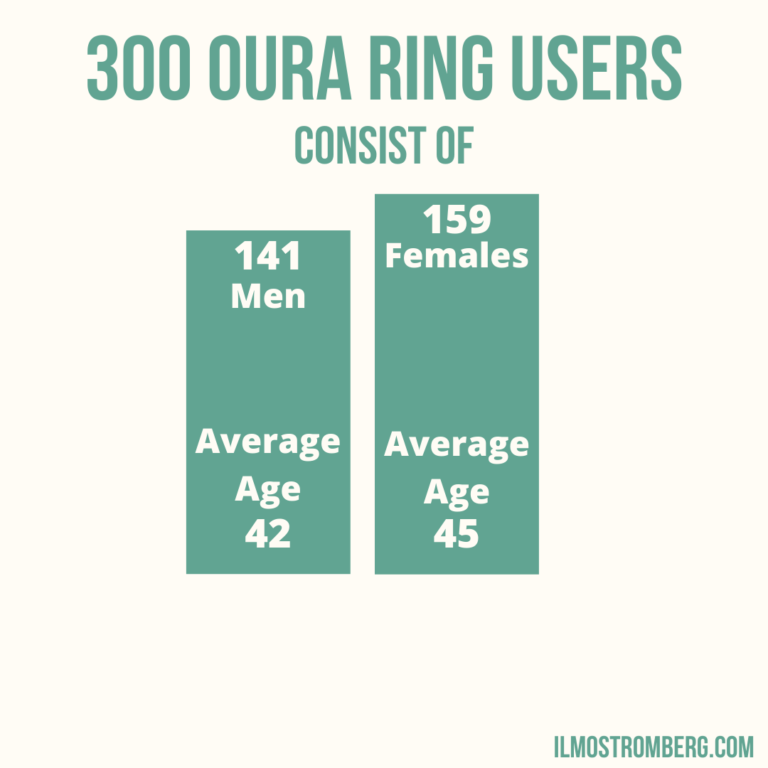
We could say that an average Oura ring user is 45 year old and female. As they own Oura ring and they are part of Oura ring facebook groups, we can make a conclusion that they are interested in their health and well-being. We don’t know their lifestyle factors like diet and level of physical activity but probably also those factors matter.
How does the data look when we have it in scatter plot by gender?
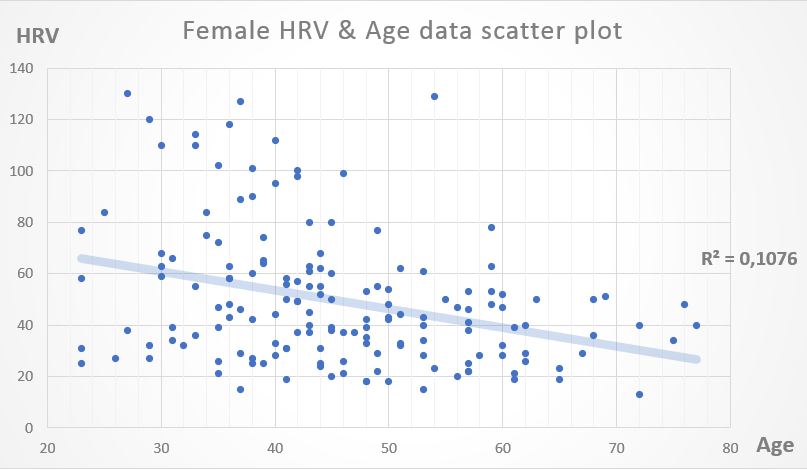
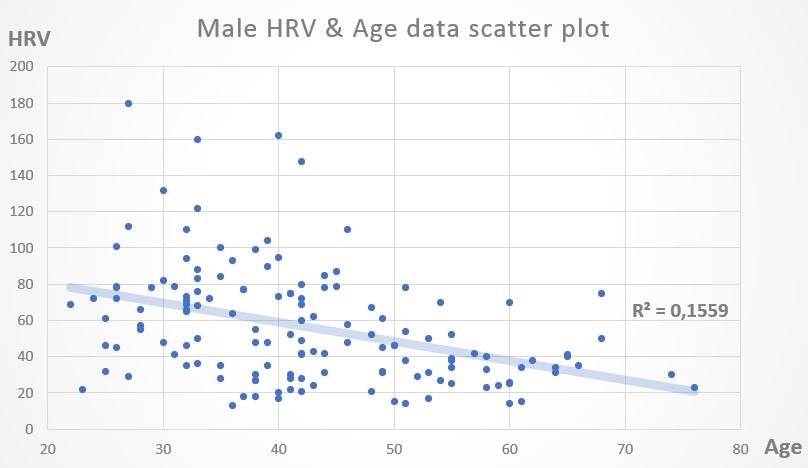
In both genders there is weak negative correlation between age and HRV. The correlation appears to be more significant with males however. This means that as we age, our HRV tends to get lower. We can see in the male chart that there are no over 50 years old rocking HRV average 80 or more and with females only one individual is reaching this. Clearly something happens to our body as we age. Now let’s look this more closely by age groups:
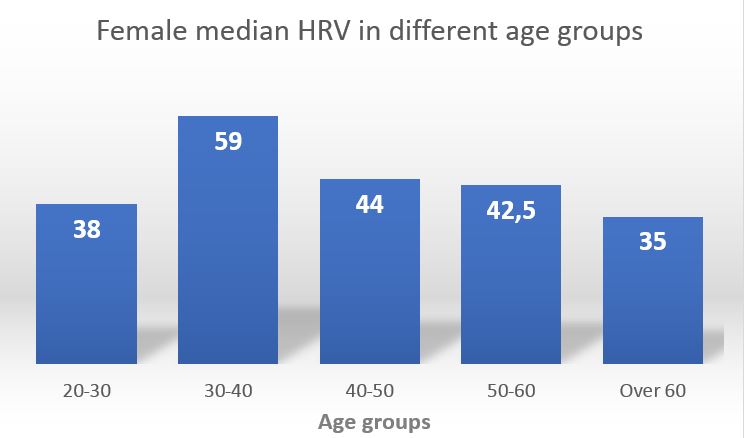
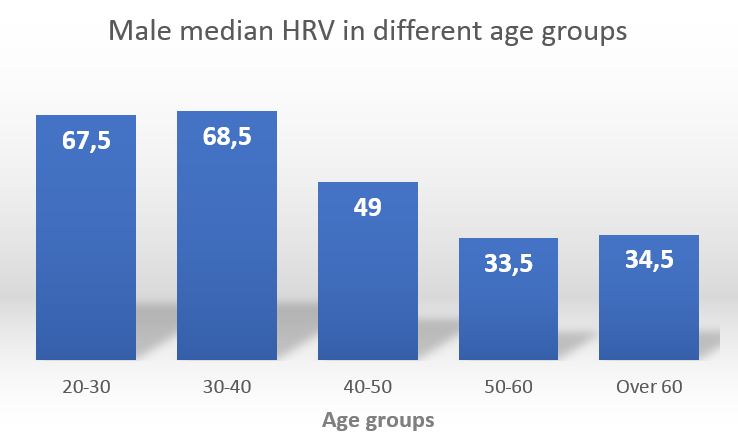
Its important to point out that sample size gets smaller as we divide users in 5 age groups. This can be seen in the female chart as group 20-30 years old only get median HRV 38 (for some other reason many young females in scope had lower HRV).
Male median chart may show the aging effect better, 20-40 years old are in the same range but then there is drastic drop in 40-50 group and it continues in 50-60 group. After that drop ends.
As the data size is only 300 Oura ring users, its good to look similar comparisons done in scientific literature.
- 1287 participants HRV data was analyzed, and study concluded that results differ by sex and age-decade groups. Men had higher mean HRV values than women. Study also divided participants into two groups, healthy & unhealthy. Healthy group had higher HRV values. [1]
- Over 8 million Fitbit users HRV data revealed interesting facts: HRV metrics decrease with age and parasympathetic function declines faster than sympathetic function. This study also states that connection between physical activity and increased HRV is merely evidence of correlation, not causation. What surprised me was that most rapid HRV decrease happens between 20-40 and more slowly after that. [2] Based on my 300 users Oura data I would have thought that biggest drop happens after 40.
2. Should you compare your HRV?
If you have a twin sister or brother, absolutely! But otherwise it’s more complicated. You have now probably guessed that there’s genetic factor on HRV. One study five years ago compared young adult twins and their HRV, they concluded that 47 to 64% is accounted by genetic factors. [3] Let’s illustrate this with following picture:
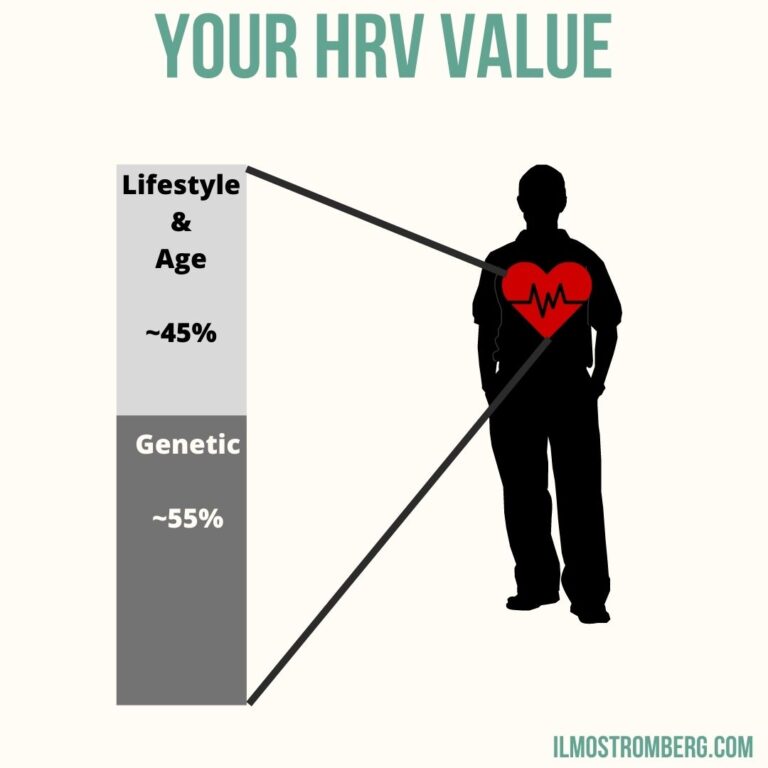
I put lifestyle and age in the same basket. We can see age as chronological age (which you can’t do nothing about) and biological age which is impacted by your lifestyle. As genetic factors have significant impact on HRV so let’s return to the comparison question: You can always compare but you cannot make much out of it. Most important thing should be your HRV and light grey box “lifestyle & age”. You cannot change your genes but you can always make better lifestyle changes to improve your health and HRV.
3. What to do if your HRV is low
There is no official definition of low HRV value based on hard science, but if we look the Oura user sample size of 300 users and take the bottom 5% values, then it will look like this:
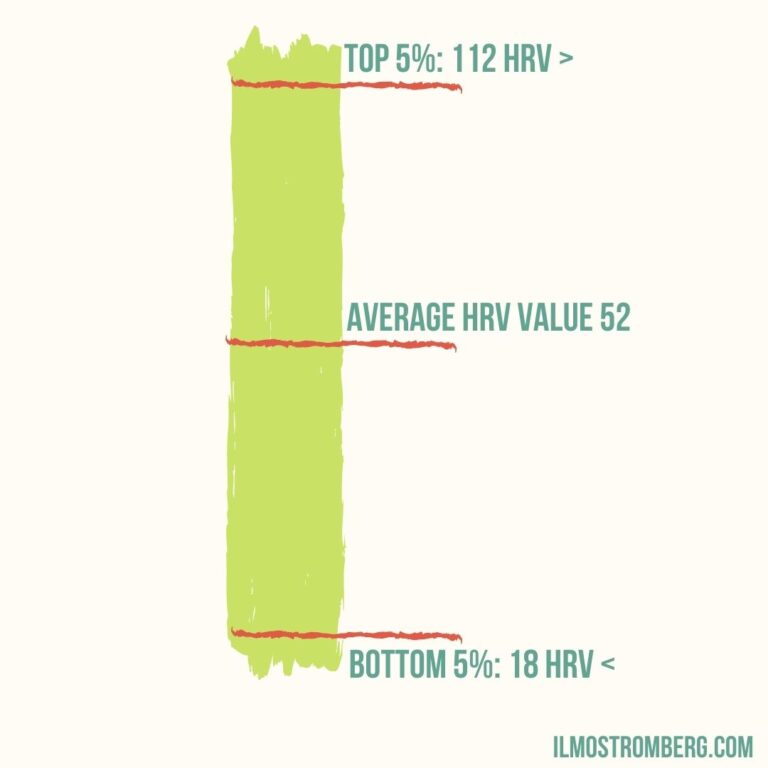
Unfortunately low HRV is risk factor, based on research low HRV has been noted as independent predictor of overall mortality in elderly individuals and its has associated with increased risk for sudden cardiac death [4].
So, what can you do if belonging into the bottom 5% or 10%? My uneducated (I’m not health care professional) suggestion is to check other parameters linked to heart health like blood pressure and cholesterol levels. If alarm signs appear there, then it is probably good to have self reflection on your lifestyle. Lifestyle however might not explain low HRV either, there could be reasons originating from diseases or e.g mental disorders. Next I’m going to list possible non-genetic reasons for low long-term HRV:
Lifestyle related:
- Being overweight [5]
- Small particles PM2,5 (living in urban areas with pollution) [6]
- Being pregnant [7]
- Social isolation [8]
- Exposure to everyday noise, example road traffic [9]
- Over training [10]
- Diabetes [11]
- Metabolic syndrome [12]
- Asthma [13]
- Cancer [14]
- Renal insufficiency (poor function of kidneys) [15]
How to increase your HRV is another topic, I have listed my favorite methods and some scientifically proved ways in my old blog post: https://ilmostromberg.com/1000-days-with-oura-ring/ However, I think this deserves own dedicated blog post so I will probably write it in the future so stay tuned and subscribe to my email list!
4. Is high HRV always good?
This one is interesting, but not so much discussed or researched topic. If you read my previous post, then you know that in some cases overtraining had been linked to higher HRV [21]. However, what I want to focus here is arrhythmias, I have seen some strange looking HRV spike pictures in Oura forums:

What could be happening here is series of arrhythmias. I searched scientific papers and found one that stated: “High high-frequency power in HRV and irregular heart rate patterns may indicate the presence of subtle atrial arrhytmia”[22]. Obviously this wouldn’t mean high HRV in the long term but strange spikes like in picture above. This strange spike isn’t really high HRV but Oura math interprets it as so. To make it more complicated, study 2007 revealed that sleep apnea increases ones heart rate variability [23]. High HRV in short term or long term might not always be good, but in most of the cases its positive!
5. Conclusion
Clearly things aren’t black and white in the world of HRV. We cannot make generalized statements as high value isn’t always good on one hand, while low value isn’t always bad, on other other. Your HRV value is different than mine because we have different genetic background and lifestyle. In the end, HRV should be just an incentive to thrive your life healthier and happier direction.

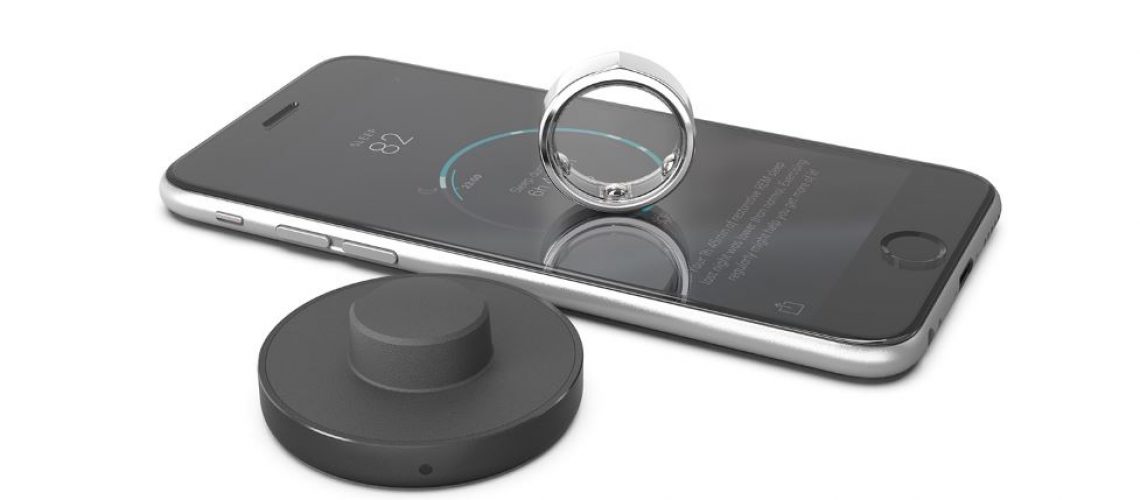
This Post Has 4 Comments
Great article! I like the way you collected analyzed the sample data. Thank you for sharing.
Thank you Daryl !
Ilmo, just found this post googling on hrv and age stratification. This is really interesting stuff you posted. I’ve worn a Oura ring for a few years. I just turned 61, my baseline would fluctuate around 50-60, but you might find this interesting. I made some significant changes to my diet (went from kind of a paleo/mediterranean mashup to ancestral) and that raised me about 5-10 points. Then a few weeks ago I started doing two rounds a day of Wim Hof breathing along with cold showers and I’m now working on 10 straight days over 70, and this morning I was at 82. And I feel amazing.
One thing I’m curious about, others have to do this, too, but I’ve yet to read anywhere about it. I use my HRV baseline to measure my reaction to different foods, supplements or meds. I had a doctor try to titrate down my compounded thyroid med and not only did I feel poorly as we did that, my HRV plummeted. Went somewhere else, did a full thyroid blood panel, and we ended up increasing my dose and I felt massively better and my HRV baseline/trend immediately went up. Seems like a great way to measure how your body reacts to different stimuli.
Hello Rick
Sorry for the late reply.
Interesting insights, you already have solid numbers for 61 years old, but you are still able to increase it, good job! I know that changing from a normal American diet to an ancestral diet should show visible increases but isn’t paleo basically an ancestral diet? What were the main changes on diet?
What time of the day do you take cold showers and Wim Hof? The morning I assume?
I like the idea of testing meds with HRV measurements. Most likely meds will have a drastic effect on HRV, that is well known. With supplements and foods, the effect most likely will be smaller unless there’s allergy example.
As my answer was late, are you still rocking HRV’s over 70?
btw, I’m just working on new HRV blogpost; 1500 days of HRV data. I will combine that data with all my other data to find correlations.
-Ilmo